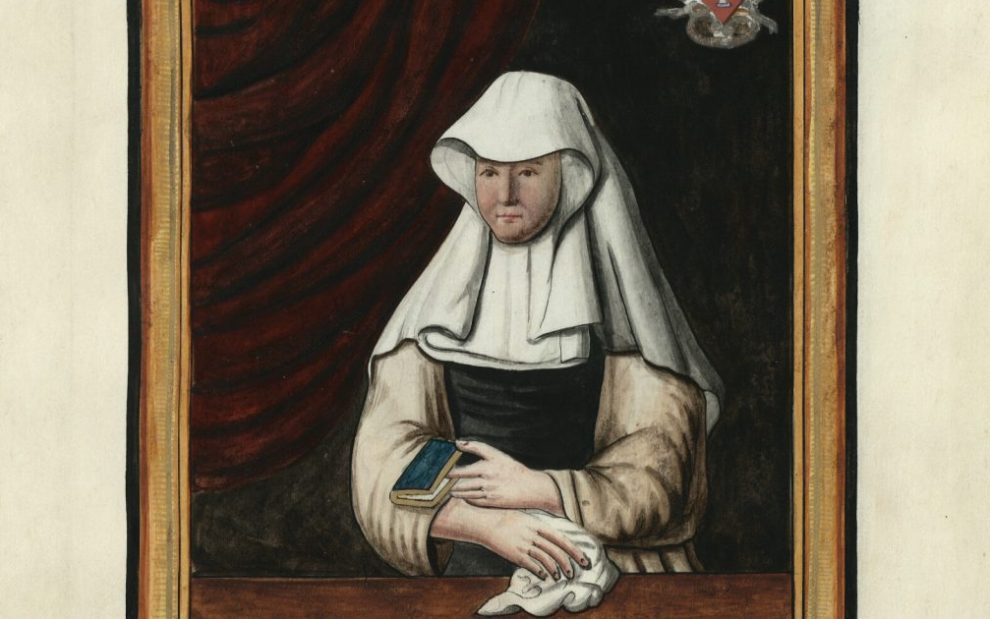“You are who you are,” says Maybe Burke, a trans artist and educator. “No one can tell you who you are but you. Whoever you know yourself to be, you are right.”
About a thousand years earlier, a woman named Hadewijch expressed similar thoughts. “What use is it for me to force my nature?” she wrote. “For my nature shall always remain what it is and conquer what belongs to it, however men may narrow its path.” A contemporary of Hadewijch’s, Mechthild of Magdeburg, said, “Each creature God made must live according to its own true nature.”
Hadewijch and Mechthild were both Beguines, members of an all-woman medieval movement. The Beguines—laywomen who created a brand-new expression of Christianity—were probably the first women’s movement in Christian history. As they sought to be true to the way of Christ, they broke free from their society’s accepted gender roles, forming communities of strong, independent women.
Meanwhile, medieval Europe was chaotic and turbulent. War and violence were rampant, while new ideas swept from Asia to Europe—as did new diseases. By the 13th century, materialism was ubiquitous. Trade flourished, the rich got richer The church was so wealthy and powerful that it was no longer recognizable as the movement Jesus began. Christ’s followers shook their heads and tried not to despair.
Of course, the Renaissance followed the Middle Ages—but today, immersed in our own tumultuous times, we have no idea what comes next. We, too, shake our heads and try not to despair.
Hadewijch would tell us that despair is never the answer. “It makes us serve evil as much as good,” she said.
Medievalist Abby Stoner writes that in the High Middle Ages, radical changes in religion, economics, and gender roles devastated old ways but also cleared a space where healthy seeds could grow. One seed that sprouted and flourished was the Beguine movement.
The movement had no founder, no guiding “rule.” It grew organically, spontaneously, as women across Northern Europe felt called to live out the gospel. These women, who had fallen in love with Jesus, lived together in communities, where they supported one another emotionally, spiritually, and financially.
At first, groups of Beguines shared a single house. Houses expanded to neighborhoods, and even villages with their own churches, hospitals, and schools, since women joining the Beguines often brought their children. Some communities let women bring their husbands as well, but others allowed no men within their walls. Celibacy was not required, however, and women were free to marry and leave whenever they wanted.
Though the Beguines had no prescribed structure, the women’s love for Jesus made their way of life sharply focused. It led them to a life of freedom, simplicity, hard work, and charity.
The medieval Beguines built their lives around prayerful contemplation—but insisted on being financially independent, which meant earning money. The first Beguines weaved textiles and sold them from their own shops, taught in schools for girls, and provided medical care to people outside their communities. For the first time anyone could remember, women were living independently without the help of any man. “Do not believe that anything you have to do is too hard for you, not if you are doing it for Jesus,” wrote Hadewijch, encouraging her sisters to overcome the ways in which men had limited their lives.
These first Beguines were wealthy upper- and merchant-class women seeking a life of deeper meaning through a relationship with Jesus. As the movement gained momentum, however, women from all socioeconomic classes flocked to join. Some had religious vocations but couldn’t afford the dowry convents required. Wars and the crusades had widowed others. Many were escaping cruel husbands or arranged marriages. Initially, some of them may not have cared much about spiritual matters, but many absorbed the movement’s energy. They, too, fell in love with Jesus.
Although many of these women had intense moments of spiritual ecstasy, Beguines viewed mysticism as a side effect (rather than the objective) of following Jesus. Hadewijch explained that the real goal of the spiritual life is “fruitive being-one”—meaning that as we mature in love, all aspects of our lives become expressions of our oneness with God and others, participating more and more in Lady Love’s actions throughout the world.
Their name for God—Lady Love—expressed their sense of intimate connection with the divine. They described this relationship with unashamedly erotic and gender-fluid metaphors. In one line, a woman might speak of Jesus as her male lover and in the next claim that role for herself, ravishing a feminine God. Hadewijch, like the other Beguines, claimed her own body as a site of intimate encounter with God. “Him shall I, the least of souls, take in my arms, eat him and drink him and have my way with him,” she wrote. “His Godhead shall never be so distant that I cannot constantly entwine my limbs with him.”
Such frank sensuality made religious men uncomfortable, and the women’s economic success threatened the all-male merchant guilds. Men sought to gain control over these rebellious women. Just as many modern Christians see the LGBTQ+ Pride movement as degenerate, many Christian men in the Middle Ages felt the same about the Beguines. They regarded these women’s lifestyle as unnatural; they feared the women’s very existence might corrupt and defile God-ordained gender roles. As Abbot Conrad of Marchtal, Germany, wrote in the 12th century, “The wickedness of women is greater than all other wickedness of the world . . . the poison of asps and dragons is more curable and less dangerous to men.”
The abbot was echoing what the church fathers had taught for centuries. Tertullian wrote that women are the “devil’s gateway.” Clement of Alexandria said a woman’s own awareness of herself “must evoke in her shame.” St. Augustine wrote, “Woman does not possess the image of God in herself but only when taken together with the male who is her head.” No wonder the disruption of gender roles caused so much discomfort.
Finally, early in the 14th century, Pope Clement decreed that the Beguine communities were forbidden. The Beguines were left with three choices: leave their communities and accept the restrictions that would be placed on their lives; join a convent (if they had the funds to pay for a dowry); or go undercover and hope to avoid the Inquisition.
Marguerite Porete was one Beguine who refused to submit. She was a traveling preacher who had written a book, The Mirror of Simple Souls. When the church forbade her to circulate her book or her ideas, she did not comply. She wrote that a woman could be “mistress and lady” over her own inner power, “for she has it all within herself, ready at her commandment.”
Around 1308, Marguerite was arrested as a heretic and brought before the Inquisition. After a year and a half in prison, she still refused to withdraw her book or recant her beliefs. The tribunal condemned her to be burnt at the stake. As she went calmly to her death, the inquisitor referred to her as a “fake woman,” but her serenity moved the watching crowd to tears.
The persecution of the Beguines continued through the 14th and 15th centuries. Although some communities managed to hold on (the last Beguine died in 2013), most submitted to the male hierarchy’s authority. Their writings and beliefs went underground for some 400 years—until, in the 19th century, they were rediscovered.
Today, the medieval Beguines continue to speak to us. Carmen Valdés, professor of spirituality at Loyola School of Theology in the Philippines, writes that we can learn several things from the Beguines: the courage to stand up for our beliefs, the commitment to improve the lives of those around us, and an intimate connection with Jesus that drives our entire lives. “They were not afraid of making society feel uncomfortable,” writes Valdés. “They went against social norms and were willing to stand against the institutional church. They went back to the gospels and made the norms of Jesus their standard.”
The 21st century’s social issues and religious controversies are different from those the Middle Ages faced—but also similar. As Catholics, we seek to follow God, but we’re not always clear how to do that.
“Love,” the Beguines would tell us. “That is always the standard, for that was Jesus’ standard.” As Pope Francis recently affirmed to a young transgender person: “God loves us as we are”—and we are called to love as we are loved.
“May your service of love be a beautiful thing,” wrote Hadewijch. “Want nothing else, fear nothing else and let love be free to become what love truly is.”
This article also appears in the January 2025 issue of U.S. Catholic (Vol. 90, No. 1, pages 15-16). Click here to subscribe to the magazine.
Image: Wikimedia Commons/Ghent University Library














Add comment